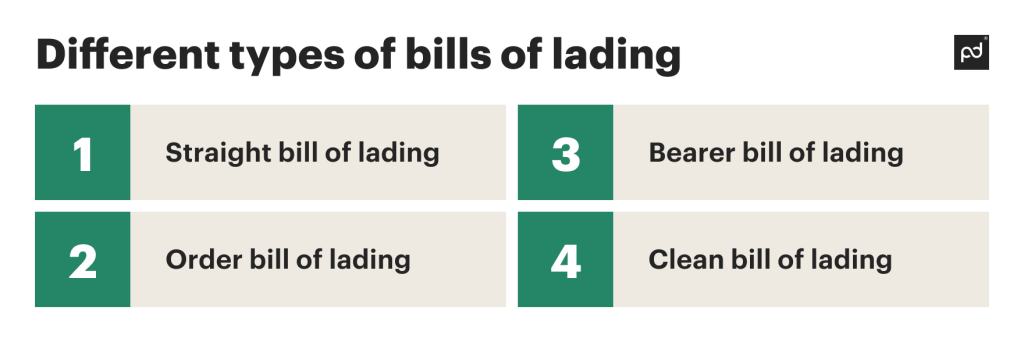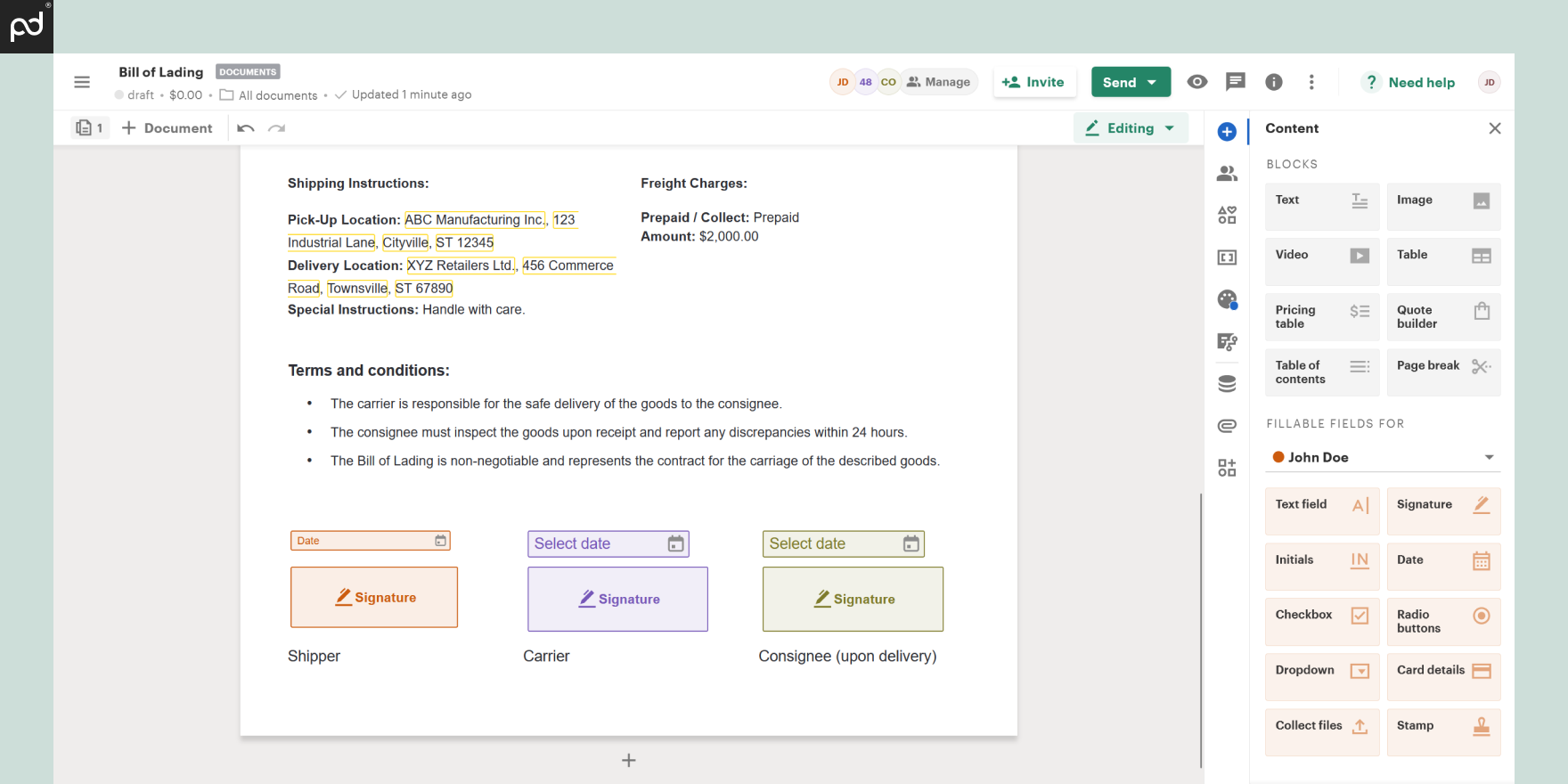Have you ever filled out or received a bill of lading and thought, “There has to be a better way to do this”?
You’re not alone.
In this guide, we break down what exactly a bill of lading (BoL) is, why it’s important to the supply chain industry, and how you can easily make your BoL process even more efficient and beautiful by using PandaDoc templates.
What is a bill of lading?
If you’ve been in the manufacturing or shipping industry for more than a few hours, you’ve likely heard of a bill of lading.
Why? Because it’s arguably the most important piece of information when shipping or receiving goods.
Essentially, it’s a receipt that details what was transported from point A to point B.
An important thing to note and keep in your back pocket is that a BoL is evidence of carriage, not a contract of carriage itself.
Now you may be asking yourself, what’s a digital bill of lading? Well, that my friends is why we’re here.
A digital BoL is the new kid on the block. It’s how shipping companies are modernizing the old-school way of doing things and coming up with a more efficient, seamless way to transfer the information on a BoL is a modern solution to this paperwork.
Electronic bills of lading, commonly called eBLs or eBoLs, help you speed up logistics related to trade.
They enable you and your team members to send, sign, and store documents electronically – reducing paper waste, manual errors, and (gasp) lost documents.
Do companies use electronic bills of lading (eBoLs)?
Let’s start with how the industry is changing. It’s slow – yes. But it’s changing.
Did you know that 45 million bills of lading are sent per year1? And in 2021 only 1.2% of these bills of lading were digital.
According to the Digital Container Shipping Association (DCSA), ocean carriers are committing to converting original bills of lading to digital in the next five years.
And that’s just one part of the entire supply chain. You could say that the tides are changing.
What are the different types of bill of lading and which should I use?
The different types of bills of lading correspond to your industry and the types of goods you’re sending.

Here’s a quick list to help you break it down:
- A straight bill of lading is a document used to communicate that goods are shipped to a specific location. No one but the assignee of the goods can receive the goods.
- An order bill of lading allows you to transfer ownership when the goods are delivered, also known as “endorsement.”
- A bearer bill of lading is used when the delivery of goods is made to the person who physically has the document. You can think of this like cash.
- A clean bill of lading means that the goods have been transferred and received without damage or defects and are in good condition.
How can switching to eBoLs benefit your business?
There are powerful benefits of switching to electronic eBoLs which contribute to their growing popularity. This includes but is not limited to:
- Being able to issue documents faster
- Allowing the consignor or carrier to sign electronically
- Cutting out the hassle of tracking and storing paper bills of lading
- Tracking freight shipments in real-time
- Documenting details on the goods, destination, consignee information, and special instructions.
- Providing the ability for an authorized representative to sign documents quickly
- Simplifying international shipment and overall supply chain
- Improving the efficiency of international trade logistics.
What is an example of bill of landing?
Here’s a simplified example of what a Bill of Lading might look like:
Bill of Lading
What are the key elements of bill of landing?
- Shipper: The party sending the goods.
- Consignee: The party receiving the goods.
- Carrier: The company transporting the goods.
- Bill of lading number: A unique identifier for the shipment.
- Date of issue: When the Bill of Lading was created.
- Description of goods: Details about what is being shipped.
- Quantity: The amount and type of goods being transported.
- Shipping instructions: Directions for picking up and delivering the goods.
- Freight charges: Cost of shipping and payment terms.
- Terms and conditions: Legal responsibilities and requirements related to the shipment.
Who pays for a bill of lading?
First, it is typically the person shipping the product to the buyer who has to pay for freight charges up front. You may hear this referred to as “prepaid” freight.
When the shipment arrives, the buyer must pay the charges called “collect” freight.
Every agreement is different but usually a bill of lading contract includes all of the costs together rather than by shipment or by product.
The contract will also include clear details on who is paying for what to keep everyone signing on the same page.
How do I create a bill of lading in PandaDoc?
If you’re ready to create your electronic bill of lading using PandaDoc’s easy, user-friendly interface, here’s how to get started:
1. Log in to your PandaDoc account.
2. Create a template.

3. Customize your document
4. Fill in the details of the bill of lading.
5. Include information such as:
- Shipper details (name, address, contact information)
- Description of the goods being sent (quantity, type, condition)
- Shipment details (origin, destination, shipping method)
- Special instructions or terms
- Add signature fields and sections.
Use PandaDoc’s editing tools to add fields for information that will vary from document to document, such as the description of the goods, freight forwarder information, number of pallets, freight classification, freight charges, presence of hazardous material, and more.
You can also include sections for signatures and dates.
7. Send the document
Once satisfied with the bill of lading, you can save it as a template for future use or send it directly to the relevant parties.
8. Track and manage
Monitor the status of the bill of lading within PandaDoc. You can see when it has been viewed, signed, and completed by the recipients.
Converting your bills of lading to digital format is easier than you might imagine
Ready to optimize your shipping operations in a quick, secure way?
Sign up for PandaDoc and see how easy it is to create digital bills of lading by modifying a pre-built template.
- DCSA’s member carriers commit to a fully standardised, electronic bill of lading by 2030. Publisher: Digital Container Shipping Association (DCSA) Show in the article ↑
Disclaimer
PandaDoc is not a law firm, or a substitute for an attorney or law firm. This page is not intended to and does not provide legal advice. Should you have legal questions on the validity of e-signatures or digital signatures and the enforceability thereof, please consult with an attorney or law firm. Use of PandaDoc services are governed by our Terms of Use and Privacy Policy.




